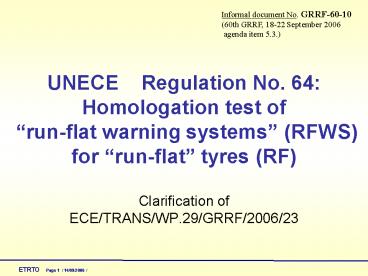UNECE Regulation No. 64: Homologation test of - PowerPoint PPT Presentation
1 / 7
Title:
UNECE Regulation No. 64: Homologation test of
Description:
European Qualifications Framework. Tekij n nimi. EQF in nutshell. 8 hierarchical levels. range from non-skilled worker to senior experts and managers ... – PowerPoint PPT presentation
Number of Views:71
Avg rating:3.0/5.0
Title: UNECE Regulation No. 64: Homologation test of
1
UNECE Regulation No. 64Homologation test of
run-flat warning systems (RFWS) for
run-flat tyres (RF)
Informal document No. GRRF-60-10 (60th GRRF,
18-22 September 2006 agenda item 5.3.)
- Clarification of ECE/TRANS/WP.29/GRRF/2006/23
2
Summary of what is necessary
- The Run-Flat-Warning-System associated with a
Run-Flat tyre must have an accuracy and a
response time such that the user is alerted well
before the tyre pressure is down to 70 kPa,
whatever the vehicle speed. - Reason At speeds allowed on Europe highways and
turnpikes, a punctured Run-Flat tyre with no
air may fail within a few minutes. - The homologation test of RFWS must take this
into account to assure the users safety, as
required by EU/ DIR-2001/95
3
ETRTO expressed concerns and has submitted for
the September GRRF meeting an Amendment to
Regulation 64 (ECE/TRANS/WP.29/GRRF/2006/23)
explaining its position.
4
1- Elements of UK Amendments Inf. GRRF-59-20
and ECE/TRANS/WP.29/2002/17/Rev.6
- Major concerns for ETRTO
- 20 min delay to alert that P 70 kPa (should be
shorter) - 20 min to alert of a system malfunction (should
be shorter) - freedom of choice (?) of test speed within 20
-120 km/h (needs to be reconsidered)
As a practical consequence, a RFWS homologated
along UK Amendment might alert of a real leak
only after more than 30 min when the tyre is
already completely flat and has exhausted its
potential ()
() the Rule would then be useless
5
Questions
What may happen - if the users speed is much
larger than the test speed for homologation ? -
if the pressure change is not a step variation
like in the test ? - if the test speed is
arbitrarily chosen within 20-120 km/h ?- if
ambient conditions are not as favourable as the
tests ?
Reported Facts
We have found reported facts of our concern in
the files of USA-DOT-NHTSA- Office of Defects
Investigations (as of July 20th, 2006)
- Out of 21 cases
- 15 cases without alert, whereas the tyre was
already flat - NHTSA is inquiring.
6
2- CONCLUSION
- ETRTOs proposal has the aim to improve the
regulatory requirements for the RFWS in order to
be efficient - ETRTO proposes
- Two alternative possibilities of test
principle - follow a method described in ISO 21750
Produce on one tyre a gradual pressure loss
between 10 kPa/min and 20 kPa/min and check .
that the system delivers an alert at the latest
for a pressure drop of 100 kPa. - modify the inf. GRRF-59-20 procedure deflate
the tyre by 100 kPa under the recommended
pressure, andcheck that the RFWS alert delay is
5 min
7
- Specification of test at two speed levels ()
- between 25 and 70 km/h, and
- at a speed equal to or higher than 130 km/h
- Delay to detect a RFWS malfunction
- 5 minutes (instead of 20 min)
() ISO 21750 for TPMS states only driving
at a speed exceeding 25 km/h but RFWS must
imperatively be tested at high speed because of
RF tyres performances































